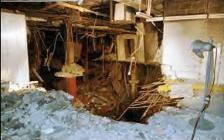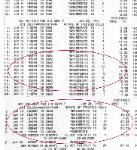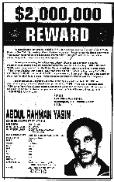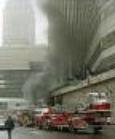
The bombing of the New York World Trade Center in 1993 was
only a "snooze alarm" for the American public -- not a wake-
up call.
The 1993 World Trade Center bombing was a plot on the scale of 9/11. It was
intended to bring down both the towers -- during working hours -- by blowing up
the first tower, which would crash onto the second tower.
It succeeded in creating a crater five stories deep in the basement floors of the
north tower.
The plot misfired, fortunately, because the unseasoned van driver, Mohammed
Salameh, abandoned the van at the bottom of the building's garage ramp instead
of maneuvering it to park next to a supporting pillar. As a result fewer than ten
people were killed, instead of the thousands of casualties that were intended.
To NY FBI, this bombing was indeed a wake-up call. NY FBI highlighted
the significance of Ramzi Yousef -- a bomb expert who had not been a
member of the initial conspiracy, and who (unlike them) was not a
militant Islamist.
Yousef provided technical bomb-building expertise for the conspiracy, and
possibly tactical/strategic management as well -- but who was behind this
terrorist mastermind, and how did he acquire his bomb-building skills?
FBI headquarters in Washington decided to keep the focus on the perpetrators in
custody, rather than on the two conspirators who got away. There was enough
evidence to convict the circle of Islamic militants, who had been easily rounded
up.
Too easily, in the view of Jim Fox (then Director of FBI-NY).
To him it seemed clear that these were merely the stooges we
were supposed to uncover, some "low-hanging fruit" intended
to divert the investigation from the sponsor of the attack.
In any case, key questions remained. The most important questions had
to do with (1) the large number of phone calls to two phone numbers in
Iraq; and (2) the murky identification of Ramzi Yousef, revealing
inconsistencies in his passport documentation and educational
background.
Several clues pointed to Iraq's involvement in the plot.
• Ramzi Yousef (known to the conspirators as "Rashid the Iraqi") had entered
the U.S. on an Iraqi passport, showing residence in Baghdad.
• Yousef's arrival in New York came just two months after the conspirators
began a series of over 40 phone calls to Iraq.
• Another conspirator, Abdul Rahman Yasin, is an Iraqi who fled to Baghdad
after the bombing. Like Yousef, Yasin arrived in New York following the series of
phone calls to Iraq. In May 1998, FBI director Louis Freeh affirmed that Yasin
remained in Iraq; nevertheless, the U.S. had never attempted to extradite him,
and he remains at large.
To summarize: a small group of militants in New York reaches out to gather
support (the phone log shows calls to several numbers overseas and to other
cities in the U.S.). By far the largest number of calls are placed to a phone
number in Baghdad, belonging to a PLO activist. Two months later, two terrorists
(who are not militant Muslims) come from Iraq join the group, and seven months
after that, the bombing takes place.
These two outsiders are also the two conspirators who got away -- one fleeing
directly back to Baghdad.
The investigators put two and two together, and came up with the
theory that Iraq had provided critical technical expertise to the
conspiracy, as well as sheltering a fugitive terrorist.
Continued on next page: New York FBI
only a "snooze alarm" for the American public -- not a wake-
up call.
The 1993 World Trade Center bombing was a plot on the scale of 9/11. It was
intended to bring down both the towers -- during working hours -- by blowing up
the first tower, which would crash onto the second tower.
It succeeded in creating a crater five stories deep in the basement floors of the
north tower.
The plot misfired, fortunately, because the unseasoned van driver, Mohammed
Salameh, abandoned the van at the bottom of the building's garage ramp instead
of maneuvering it to park next to a supporting pillar. As a result fewer than ten
people were killed, instead of the thousands of casualties that were intended.
To NY FBI, this bombing was indeed a wake-up call. NY FBI highlighted
the significance of Ramzi Yousef -- a bomb expert who had not been a
member of the initial conspiracy, and who (unlike them) was not a
militant Islamist.
Yousef provided technical bomb-building expertise for the conspiracy, and
possibly tactical/strategic management as well -- but who was behind this
terrorist mastermind, and how did he acquire his bomb-building skills?
FBI headquarters in Washington decided to keep the focus on the perpetrators in
custody, rather than on the two conspirators who got away. There was enough
evidence to convict the circle of Islamic militants, who had been easily rounded
up.
Too easily, in the view of Jim Fox (then Director of FBI-NY).
To him it seemed clear that these were merely the stooges we
were supposed to uncover, some "low-hanging fruit" intended
to divert the investigation from the sponsor of the attack.
In any case, key questions remained. The most important questions had
to do with (1) the large number of phone calls to two phone numbers in
Iraq; and (2) the murky identification of Ramzi Yousef, revealing
inconsistencies in his passport documentation and educational
background.
Several clues pointed to Iraq's involvement in the plot.
• Ramzi Yousef (known to the conspirators as "Rashid the Iraqi") had entered
the U.S. on an Iraqi passport, showing residence in Baghdad.
• Yousef's arrival in New York came just two months after the conspirators
began a series of over 40 phone calls to Iraq.
• Another conspirator, Abdul Rahman Yasin, is an Iraqi who fled to Baghdad
after the bombing. Like Yousef, Yasin arrived in New York following the series of
phone calls to Iraq. In May 1998, FBI director Louis Freeh affirmed that Yasin
remained in Iraq; nevertheless, the U.S. had never attempted to extradite him,
and he remains at large.
To summarize: a small group of militants in New York reaches out to gather
support (the phone log shows calls to several numbers overseas and to other
cities in the U.S.). By far the largest number of calls are placed to a phone
number in Baghdad, belonging to a PLO activist. Two months later, two terrorists
(who are not militant Muslims) come from Iraq join the group, and seven months
after that, the bombing takes place.
These two outsiders are also the two conspirators who got away -- one fleeing
directly back to Baghdad.
The investigators put two and two together, and came up with the
theory that Iraq had provided critical technical expertise to the
conspiracy, as well as sheltering a fugitive terrorist.
Continued on next page: New York FBI
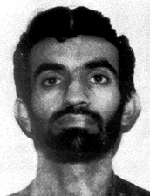
Ramzi Yousef, convicted in the
1993 World Trade Center
bombing.
1993 World Trade Center
bombing.
| The 1993 World Trade Center Bombing |
